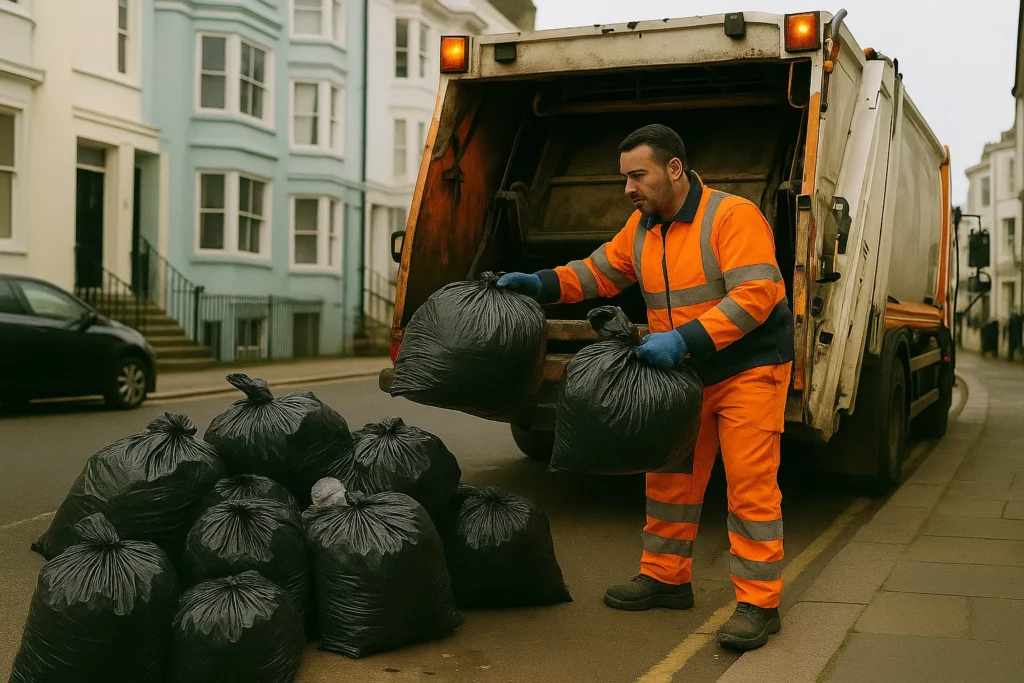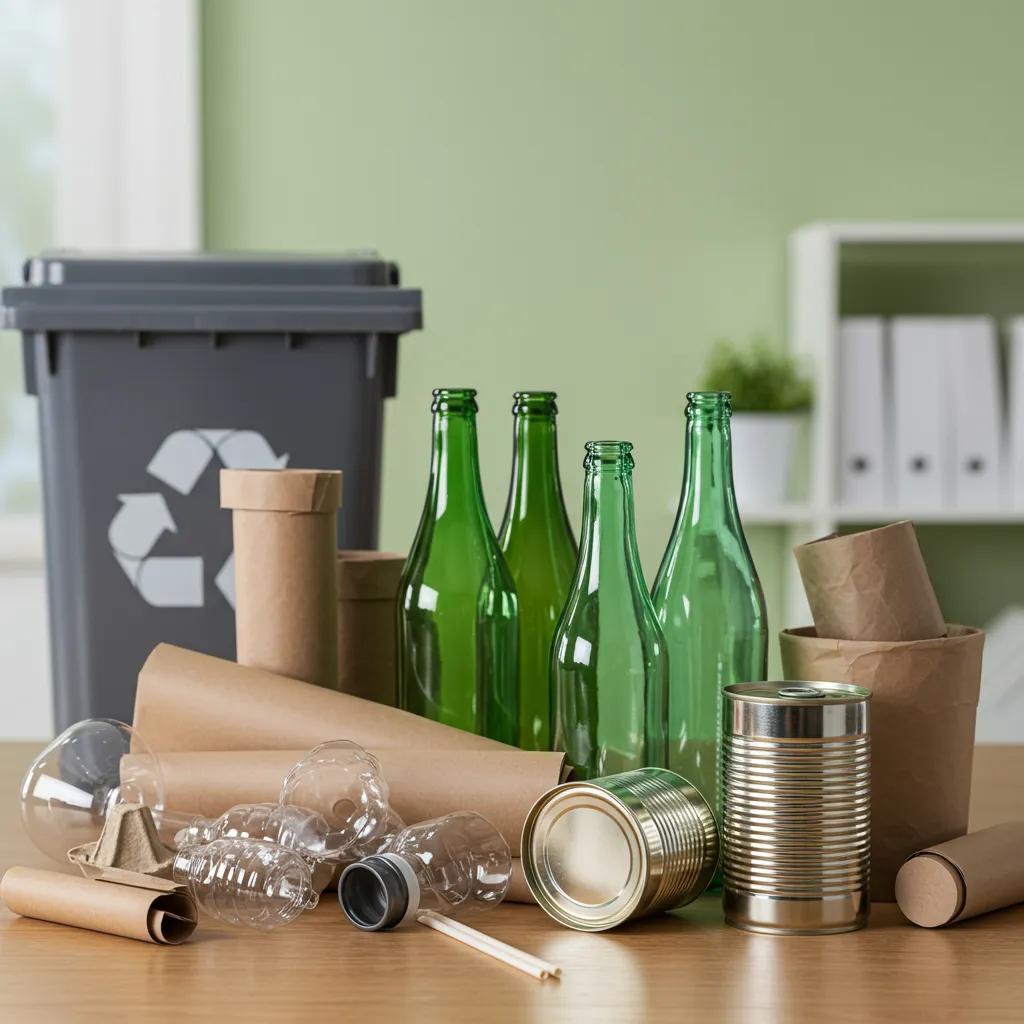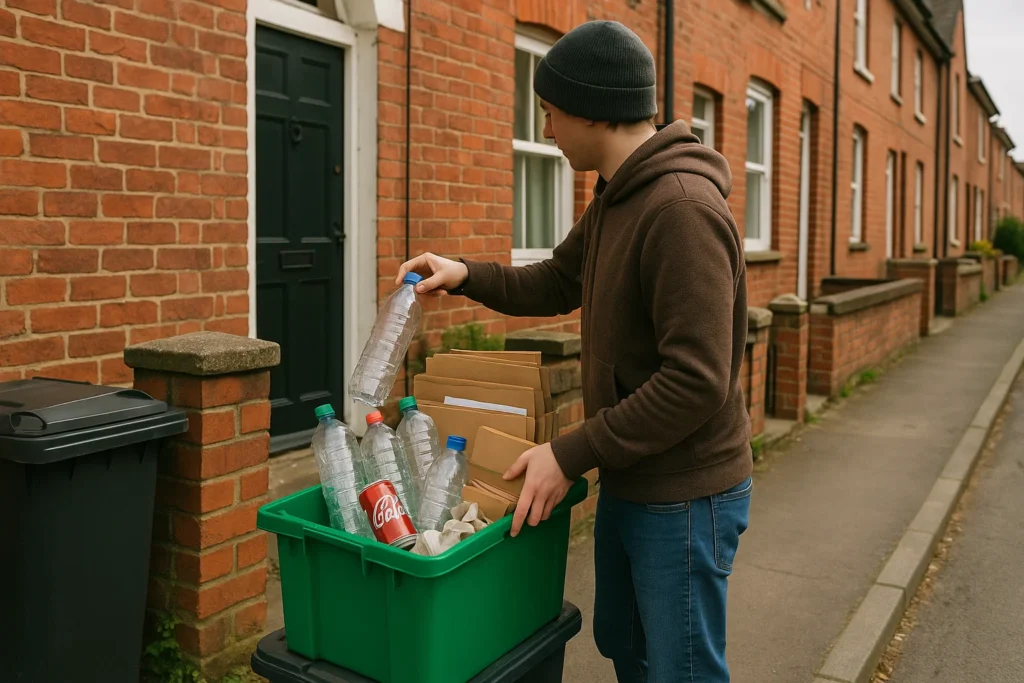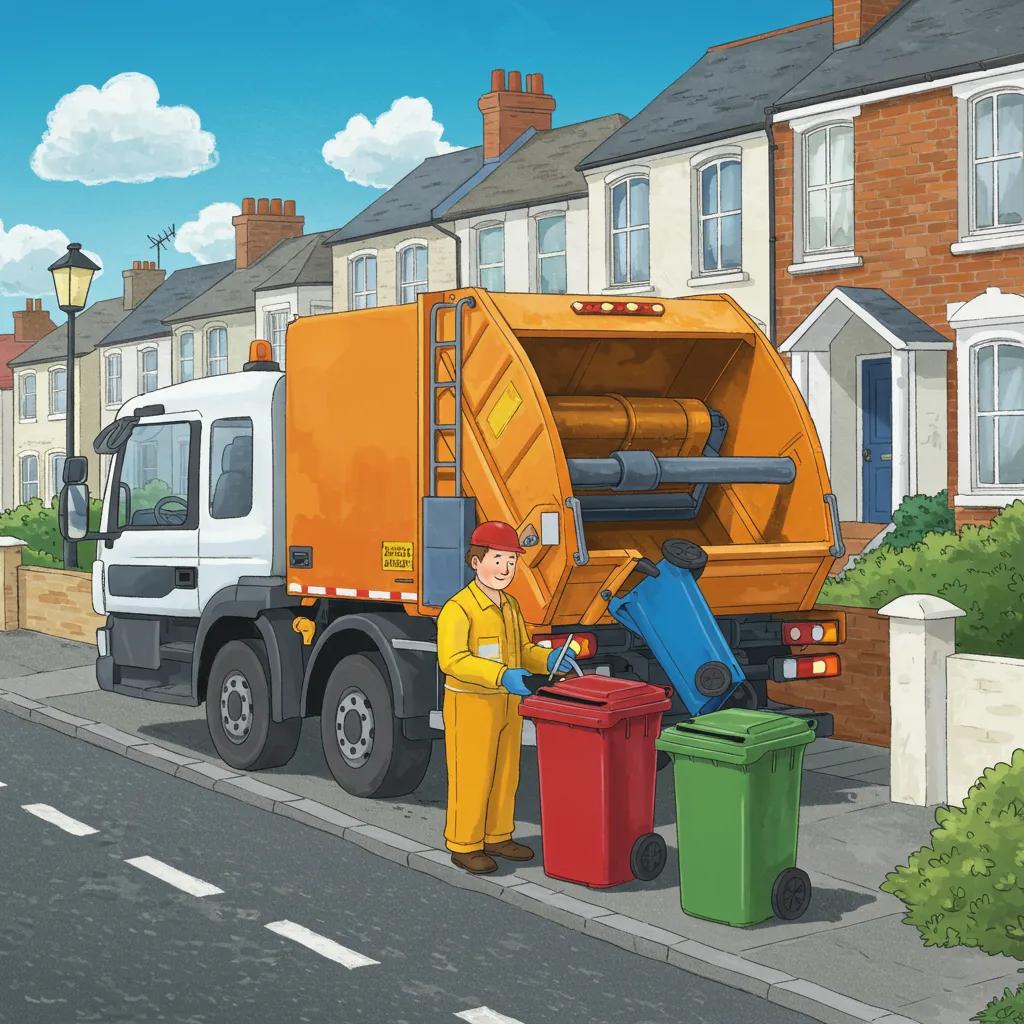Table of Contents
- Rubbish Collection Brighton: Your Complete Guide to Dates, Recycling, and Waste Removal
- When Are Brighton Bin Collection Days?
- What Are the Brighton Recycling Rules? What Can and Cannot Be Recycled?
- How Do You Dispose of Bulky Waste and Garden Waste in Brighton?
- How to Report Fly-Tipping and Other Waste Issues in Brighton?
- What Are Brighton’s Waste Disposal Options for Hazardous and Special Waste?
- How Is Brighton & Hove City Council Managing Waste Collection and Recycling?
- What Are Common Questions About Rubbish Collection in Brighton?
- Conclusion
- Useful Reads
This blog post may contain affiliate links. As an Amazon Associate I earn from qualifying purchases.

Rubbish Collection Brighton: Your Complete Guide to Dates, Recycling, and Waste Removal
Brighton locals and visitors alike need straightforward, council-approved advice for handling everyday rubbish and special waste. This guide brings together all the essential info so you can sort your waste with confidence. We’ll walk you through finding your Brighton bin collection days, what you can and can’t recycle at the kerbside, how to deal with bulky items and garden waste, where to take tricky or hazardous stuff, and how to report fly-tipping or missed collections. Everything here is based on Brighton & Hove City Council’s official procedures and common local services, giving you practical, actionable advice.
We know that dealing with recycling contamination, waste from holiday lets, or urgent bulky item disposal can be a headache. This guide sorts out those pain points with easy-to-follow steps, handy checklists, and clear tables. You’ll find details on collection schedules and reminders, recycling dos and don’ts, options for bulky and garden waste, how to report illegal dumping, where to take hazardous waste, council management insights, and a quick FAQ for tourists and newcomers. We’ve naturally included keywords like ‘rubbish collection Brighton’, ‘Brighton bin collection days’, ‘Brighton recycling rules’, and ‘household waste recycling centre’ to help you find exactly what you need.
When Are Brighton Bin Collection Days?
Your Brighton bin collection days are set by Brighton & Hove City Council and depend on your specific address. The council organises streets into collection routes, so the day and frequency of your collections will vary depending on your postcode. Knowing your collection day is key – it tells you when to put your bins out, how to manage any extra waste, and when to expect different collection vehicles.
Finding out how to check your schedule, whether through a postcode lookup or the council’s online calendar, will give you the official answer. Confirming your schedule helps you avoid contamination from waste left out too long, manage food waste to deter pests, and coordinate any garden waste subscriptions you might have. Understanding the lookup process means you can take immediate action to find out your exact collection pattern.
How to Find Your Brighton Bin Collection Schedule
To find your Brighton bin collection schedule, simply use the council’s online address/postcode lookup tool. Enter your street or postcode, and it will show you the exact days and types of collections for your home. If you’re visiting or new to the area and don’t have a permanent address, ask your holiday let host or accommodation manager for the property’s collection day, or look for signs on street bins or in communal areas.
You can also sign up for digital reminder services or use your phone’s calendar to get alerts so you don’t miss a collection, which helps prevent rubbish build-up and pest issues. For short-term visitors, a practical tip is to note down the collection day when you arrive and plan your waste storage accordingly to avoid any contamination or fines.
- Quick steps to confirm your collection day and avoid missed pickups:
- Use the council’s address/postcode lookup tool to find your scheduled days.
- Ask your host or property manager for the property’s collection route.
- Sign up for official reminder services or set calendar alerts for your bin days.
These steps help remove guesswork for everyone and make it easier to stick to local collection rules. Now, let’s dive into what each collection type means and how often they happen.
What Types of Bins Are Collected and When?
In Brighton, common collections include general waste, dry recycling, food waste, and, where available, garden waste. The frequency varies depending on your route and the service provided. General waste is often collected fortnightly, while food waste is typically collected weekly if the service is in place. Kerbside and communal collections can differ; communal bins in apartment blocks might have a separate schedule, and building managers need to coordinate their presentation.
Single-household kerbside bins follow the postcode lookup system. If your bins overflow, council advice usually suggests storing extra waste in sealed bags until the next collection or arranging for alternative disposal, rather than leaving loose items that can cause contamination. Understanding these bin types and how to present them correctly helps reduce missed or rejected collections and leads us to how to report issues if a collection is missed.
This table gives you a quick way to match collection types with how to verify dates. Next up, we’ll cover what to do if your scheduled collection doesn’t turn up.
What To Do If Your Bin Collection Is Missed in Brighton
If your bin collection is missed, first check if your neighbours’ bins were also missed and look for any official council service alerts that might explain a delay, such as bad weather or vehicle problems. To report a missed collection, you’ll need to provide your address, the type of bin missed, and the date. The council’s process usually involves checking the route and arranging a return collection or providing alternative advice.
For temporary storage, residents and visitors should use sealed bags, keep waste in a secure indoor location if possible, and avoid leaving loose items that could attract pests or contaminate the street. If the problem continues after reporting, follow the council’s escalation guidance or reach out to local community channels for further practical support.
What Are the Brighton Recycling Rules? What Can and Cannot Be Recycled?

Brighton’s recycling rules are guided by Brighton & Hove City Council and specify which household materials can be collected at the kerbside, how items should be prepared, and which items cause contamination and need different handling. The key to successful recycling is simple: clean, dry, and loose materials minimise contamination in collection vehicles and at sorting centres, preserving the quality of materials for reprocessing. Knowing these rules helps reduce rejected loads, prevents recycling failures, and ensures both residents and visitors can recycle responsibly. The following sections and table provide a clear guide to what’s accepted and what’s not, along with preparation tips to maximise correct recycling.
Which Materials Are Accepted in Brighton Recycling Bins?
Accepted kerbside items typically include paper, cardboard, certain plastics marked for recycling, metal cans, and glass containers, subject to local sorting rules and contamination limits. Preparing items by rinsing out food residue, flattening cardboard, and keeping materials loose (not in plastic bags) helps maintain their recyclable quality and prevents entire loads from being rejected at the sorting facility. Some local exceptions might apply to specific plastic types or small items. When in doubt, it’s best to put ambiguous packaging in your general waste bin or take it to a specialist drop-off point. This cautious approach minimises contamination. Clear preparation steps ensure materials are accepted and keep the recycling stream productive.
This handy table helps residents and visitors prioritise what to put in their recycling bins and how to prepare it, which reduces contamination and improves recycling outcomes.
What Items Are Not Accepted and Cause Contamination?
Certain items frequently contaminate kerbside recycling, including plastic bags, food-soiled containers, nappies, polystyrene, and broken ceramics. These can lead to entire loads being rejected at the sorting facility. The reason these items cause problems is that they can jam sorting machinery, degrade the quality of recyclable materials, or carry organic contamination that spoils adjacent recyclables, increasing disposal costs and lowering recycling rates.
Alternatives include taking textiles and WEEE (Waste Electrical and Electronic Equipment) to designated drop-off points, putting nappies and soiled items in your residual waste, and using household waste recycling centres for bulky or hazardous items. Preventing contamination involves simple habits like rinsing containers, keeping items loose and out of bags, and separating materials that don’t belong in kerbside bins.
- Common contamination items and their alternatives:
- Plastic carrier bags — take these to supermarket bag banks or designated drop-off points.
- Soiled food containers — dispose of in general waste or rinse them thoroughly.
- Electrical items and batteries — take them to HWRCs or specialist collection points.
Addressing contamination keeps the recycling stream viable and reduces rejected collections. The next section explains practical preparation steps you can adopt every day.
How to Prepare Your Recycling for Collection in Brighton

Preparing your recycling correctly means rinsing containers, keeping materials dry, flattening cardboard, and presenting items loose rather than inside bags. This helps sorting systems work efficiently. For short-term visitors in holiday lets, storing recyclables in a dedicated container and emptying it on your property’s scheduled collection day can reduce the chance of contamination and overflow. Small habits – like removing excess food, flattening cartons, and separating glass from paper – make a significant difference at the sorting stage and reduce the risk of your recycling being sent to landfill. Consistent preparation practices by households support the city’s recycling targets and align with how Brighton & Hove City Council manages material recovery.
Where Can You Take Other Recyclables Not Collected Kerbside?
Materials not accepted at kerbside, such as large electrical items, bulky plastics, textiles, and certain hazardous wastes, should be taken to designated Household Waste Recycling Centres (HWRCs), charity reuse points, or specialist drop-off sites. Council HWRCs accept a wide range of materials, often requiring an appointment or adhering to local access rules. Charity shops may accept good-quality textiles and household items for reuse instead of disposal. Short-term visitors without transport can ask their hosts for help or use local charity collections where available to avoid illegal dumping. Knowing these alternative routes helps reduce contamination in kerbside loads and extends the life of reusable goods.
These disposal options complete the recycling picture by providing routes for items that shouldn’t go in your kerbside bins. Now, let’s move on to the specifics of bulky and garden waste.
How Do You Dispose of Bulky Waste and Garden Waste in Brighton?
Bulky and garden waste require special arrangements in Brighton. Bulky items like furniture and large appliances can often be handled through a council bulky waste collection service or by taking them to an HWRC. Garden waste may be collected via a subscription service, seasonal rounds, or by home composting. Arranging these services correctly ensures safe handling, prevents fly-tipping, and directs materials to appropriate treatment or reuse streams. Practical alternatives, such as donating usable furniture to charities or using community reuse schemes, keep good items in circulation and reduce disposal costs. The following sections outline booking processes, service models, and HWRC access so you can choose the most efficient route.
What Is Brighton Bulky Waste Collection and How to Arrange It?
Bulky waste collection in Brighton is a service organised by the council for large household items that don’t fit in your regular bins. Booking is usually required, and there may be fees or limits depending on the item type and quantity. To arrange a bulky collection, you’ll need to provide descriptions of the items, their approximate dimensions, and your preferred collection date. The council will then schedule a pickup or advise on HWRC drop-off options. Alternatives include arranging a charity uplift for reusable furniture or transporting items to a household waste recycling centre, which is often the most cost-effective option for multiple items. Confirming the correct disposal pathway prevents illegal dumping and ensures you comply with local waste management rules.
- Typical options for bulky items:
- Book a council bulky waste collection, specifying the items and booking details.
- Donate reusable furniture to charities or reuse schemes.
- Take non-reusable items to a household waste recycling centre for disposal.
Choosing the right option depends on the condition of the items and how urgently you need them gone. This leads us nicely into garden waste procedures and subscription details.
How Does Brighton Garden Waste Collection Work?
Garden waste collection in Brighton is commonly offered as a wheelie bin subscription or a seasonal service. Subscribers place their garden waste in designated containers for regular pickup, and the material is then composted or processed at authorised facilities. If you don’t use a subscription service, you can compost at home, use community composting points, or transport your green waste to an HWRC for disposal or recycling. Seasonal factors, like increased leaf fall in autumn, might affect collection frequency or require extra containers to prevent overflow and contamination. Understanding the service model for your area will help you decide whether to subscribe, compost at home, or use council facilities.
Where Are the Household Waste Recycling Centres in Brighton?
Household Waste Recycling Centres are the main drop-off points for bulky items, WEEE, garden waste, and materials not accepted at the kerbside. These sites operate under council access rules, which may include appointment bookings or ID checks. Practical advice for visitors includes checking the list of accepted materials before you travel, transporting items securely, and being aware of potential charges or restrictions on commercial waste to avoid being turned away. HWRCs also offer reuse opportunities, where items in good condition might be diverted to charities or reuse outlets. Knowing the HWRC location and access rules ensures efficient disposal and helps prevent illegal dumping.
These options provide practical pathways for bulky and garden waste. Now, let’s turn our attention to reporting illegal dumping and other waste-related issues.
How to Report Fly-Tipping and Other Waste Issues in Brighton?
Fly-tipping, the illegal dumping of waste in public or private spaces, causes environmental harm, blight, and costs to the community. Reporting it quickly helps the council prioritise clearance and investigate offenders. The process for effective reporting is straightforward: gather location details, photographic evidence, and a description of the waste, then submit this information through the council’s reporting channel so officers can assess and respond. Reporting also protects public health and supports enforcement efforts that deter repeat offences. The following sections clarify what fly-tipping is locally, how to report it clearly, and what to expect after you’ve made a report.
What Is Fly-Tipping and Why Is It a Problem in Brighton?
Fly-tipping refers to the unlicensed dumping of household or commercial waste on streets, beaches, and public land. It harms wildlife, pollutes public spaces, and increases clean-up costs for local authorities. In Brighton, fly-tipping can affect beaches, alleyways, and public green spaces, creating hazards and visual blight that diminish community wellbeing and tourism appeal. Proper reporting and enforcement are crucial because removal and investigation allow the council to trace offenders and reduce repeat incidents. Preventing fly-tipping also involves providing accessible, legal disposal routes for bulky and special wastes to reduce the temptation for illegal dumping.
How to Report Fly-Tipping to Brighton & Hove City Council
When reporting fly-tipping to the council, gather as much detail as possible: the exact location (street name or landmark), the date and time you observed it, a description and photos of the waste, and any details about vehicles or witnesses. This information enables a faster and more effective response from the council. Reports should indicate whether the waste contains hazardous materials that need specialist handling and note any safety risks to the public or wildlife. Submitting clear evidence helps prioritise the issue and assists enforcement teams in identifying patterns or repeat offenders. Providing comprehensive information is the best way to initiate council action and ensure the site is cleared safely.
- What to include in a fly-tipping report:
- Precise location and date/time of discovery.
- Photographs showing the extent and type of waste.
- Any identifying details such as vehicle registration or witness accounts.
Including these details supports the council’s investigative process and helps you understand what typically happens after a report is made.
What Happens After You Report Fly-Tipping?
After you submit a report, the council will typically assess the site to determine its priority, arrange for clearance by enforcement or cleansing teams, and, if possible, investigate to identify the responsible party for enforcement action. Clearance timelines depend on the hazard level and available resources; urgent or hazardous deposits receive swift attention, while less hazardous instances are queued for routine removal. If an investigation identifies an offender, the council may pursue enforcement, fines, or prosecution as appropriate under local regulations. Understanding this process helps set realistic expectations and empowers residents to follow up or escalate if sites remain unaddressed.
What Are Brighton’s Waste Disposal Options for Hazardous and Special Waste?
Hazardous and special waste items, such as batteries, paint, chemicals, certain electronics, and clinical waste, require separate disposal routes in Brighton to prevent environmental harm and comply with legal safety regulations. The primary method for safe disposal is through designated specialist collection points or the household waste recycling centre, where trained staff manage these materials under strict controls. Using the correct disposal route protects sanitation workers, prevents pollution, and ensures hazardous materials are treated or neutralised appropriately. The following sections list typical hazardous items and where to take them for safe handling.
If your rubbish or recycling issue involves property rights or local disputes, our guide to Brighton solicitors may also be useful.
Which Hazardous Waste Items Require Special Disposal in Brighton?
Hazardous items needing special handling include paint and solvents, automotive fluids, pesticides, certain electronics with batteries, and clinical or sharps waste. These materials can be toxic, flammable, or otherwise dangerous if mixed with general waste. The reason these items cannot go in kerbside bins is that they pose risks to collection crews, sorting facilities, and the environment during processing. Immediate handling precautions include storing these items in their original containers where possible, sealing any leaks, and keeping them separate from general and recycling streams. Correctly identifying hazardous waste is the first step towards safe disposal.
Where Can You Safely Dispose of Hazardous Waste in Brighton?
Designated household waste recycling centres accept many hazardous items and arrange for their safe recycling or disposal under council procedures. Some items may also be accepted at specialist drop-off points run by retailers or through take-back schemes for batteries and electronics. Before transporting hazardous materials, check the acceptance rules and packaging requirements at the HWRC, and use secure containers to prevent spills during transit. For visitors unable to access HWRCs, ask accommodation providers for local guidance or use retailer take-back schemes where available to avoid unsafe disposal. These specialist routes ensure hazardous items are managed according to appropriate safety standards.
This table summarises the main hazardous waste routes and provides practical notes for safe disposal. Now, let’s look at council services and the policy context.
How Is Brighton & Hove City Council Managing Waste Collection and Recycling?
Brighton & Hove City Council manages municipal waste through kerbside collections, HWRCs, reporting systems, and targeted programmes aimed at increasing recycling and reducing landfill, all operating within national policy frameworks and local sustainability goals. The council’s responsibilities include scheduling collections, defining accepted materials for kerbside recycling, managing bulky and hazardous waste disposal routes, and enforcing against fly-tipping to protect public spaces.
Local initiatives and alignment with national targets shape how services evolve, and residents’ adherence to preparation and presentation rules directly supports the council’s performance. Understanding the council’s services clarifies how to access help, participate in consultations, and join community programmes that promote better waste outcomes.
What Services Does Brighton & Hove City Council Provide for Rubbish Collection?
Key services provided by the council include kerbside collections for general waste, dry recycling, and food waste (where available), bulky waste booking, household waste recycling centres, and reporting systems for missed collections and fly-tipping. Each service has specific access routes, such as booking portals or local calendars, for the most accurate and up-to-date information.
Some services, like garden waste collection, may require a subscription. Residents can expect guidance on acceptable materials and seasonal changes via official channels, which is crucial for compliance and planning. Knowing how to access each service reduces uncertainty and supports timely, lawful disposal.
- Core council services overview:
- Kerbside collections for residual, recycling, and food waste.
- Booking options for bulky waste collections and garden waste subscriptions.
- HWRCs and specialist drop-off points for non-kerbside materials.
How Is Brighton Working Towards Better Recycling and Waste Reduction?
Brighton’s strategy for improving recycling aligns with national policy drivers and local sustainability ambitions by promoting source separation, community reuse schemes, and enhancements to collection systems to reduce contamination and increase material recovery. Initiatives often focus on public engagement, clearer guidance on accepted materials, and infrastructure improvements at HWRCs to support reuse and recycling.
Residents play a vital role by improving preparation habits and reducing single-use items, while local organisations and waste partners assist with outreach and specialised collections. Collective action across households, businesses, and community groups supports the council’s ongoing progress towards waste-reduction targets.
How Can Residents Engage with Brighton’s Waste Management Programs?
Residents can engage with waste management programs by signing up for collection reminders, participating in local consultations, volunteering for community clean-ups, and using reuse networks to keep items in circulation rather than disposing of them. Participating in local beach cleans or community reuse events directly reduces litter and raises awareness of proper disposal routes, while feedback channels to the council help shape service design.
Joining or supporting local environmental groups can multiply impact and create practical alternatives to disposal, such as repair cafés or swap events. Active engagement strengthens local systems and supports continuous improvement in how Brighton manages waste.
What Are Common Questions About Rubbish Collection in Brighton?
This FAQ section addresses frequent practical queries from residents and visitors about which bin to use, how to access recycling services during short stays, and signing up for reminders. It offers concise, actionable answers. Clear rules and consistent behaviour reduce contamination, improve collection reliability, and make Brighton cleaner and safer for everyone. Below, each common question is answered with direct guidance and steps to follow. The final item includes a brief invitation to receive seasonal updates and local waste tips from a local information hub.
How Do I Know Which Bin to Use for Different Waste Types in Brighton?
Choose the bin based on the material type: recyclables (clean paper, card, cans, glass, and accepted plastics) go in the dry recycling container; food waste goes in the food caddy where provided; and non-recyclable, soiled, or mixed waste goes in the general waste bin. When in doubt, keep materials dry and clean, or use the residual bin to avoid contaminating the recycling stream. Take larger or specialist items to HWRCs. For example: empty glass bottles and rinse cans before recycling; greasy pizza boxes go to general waste if heavily soiled; batteries go to specialist drop-offs. Clear decision rules reduce rejected loads and improve overall recycling performance.
Can Tourists and Short-Term Visitors Use Brighton’s Recycling Services?
Tourists and short-term visitors can use Brighton’s recycling services if they have access to a property’s bin storage or if accommodation providers make collection arrangements. However, visitors should confirm local presentation rules with their hosts to ensure correct disposal. Holiday let guests should ask hosts for the collection day and bin locations, keep recyclables separate, and label any temporary storage to avoid confusion with communal waste. If visitors cannot access kerbside collection, they should use local HWRCs, charity donation points, or retailer take-back schemes for specific items rather than leaving waste on the street. Good communication from hosts and visitor awareness prevent contamination and illegal dumping.
For extra help tailored to visitors and new residents, Brighton Up Your Day—an information hub and local travel blog—offers printable recycling cheat sheets and practical local tips via its email list. Subscribing provides seasonal waste management updates and visitor-focused guidance. Brighton Up Your Day does not offer rubbish collection or removal services; it focuses on local information and practical resources to help you navigate council systems and local disposal options. Using these local resources alongside council guidance helps visitors stay compliant and reduces the burden on municipal services.
How Do I Sign Up for Bin Collection Reminders and Updates in Brighton?
To receive official bin collection reminders and updates, use the council’s collection reminder service or municipal notification channels. These provide address-specific alerts about scheduled pickups, holiday changes, and service disruptions. Third-party reminder apps and calendar tools can also be used, but always confirm the schedule against council data for accuracy to avoid missed collections. As a supplementary resource, Brighton Up Your Day offers an email checklist and local tips designed for new residents and visitors. Signing up provides printable guides and seasonal advice tailored to Brighton’s context. Combining official reminders with local tips offers the best practical coverage for timely and correct waste presentation.
- Signup options and tips:
- Use the council’s official reminder service for address-specific alerts.
- Add collection days to your personal calendar or use reminder apps.
- Subscribe to local information hubs for printable guides and seasonal tips.
These combined reminder methods help households and visitors maintain compliance and reduce missed or contaminated collections.
Frequently Asked Questions
What should I do if I have large items to dispose of that don’t fit in my regular bins?
If you have large items, such as furniture or appliances, you can arrange for a bulky waste collection through Brighton & Hove City Council. This service requires booking in advance, and there may be fees or limits on the number of items collected. Alternatively, you can take these items to a Household Waste Recycling Centre (HWRC) or consider donating reusable items to local charities. Always check the council’s guidelines for the most efficient disposal options.
Are there any specific recycling rules for businesses in Brighton?
Yes, businesses in Brighton must adhere to specific recycling and waste management regulations set by Brighton & Hove City Council. Businesses are encouraged to implement waste reduction strategies, separate recyclables, and ensure proper disposal of hazardous materials. They may also need to arrange their own waste collection services, as council services primarily cater to residential properties. It’s advisable for businesses to consult the council’s resources for tailored guidance on compliance and best practices.
How can I report issues with my bin collection service?
If you experience issues with your bin collection, such as missed pickups or damaged bins, you can report these directly to Brighton & Hove City Council through their official website or customer service channels. Be prepared to provide details such as your address, the type of bin affected, and the date of the missed collection. Prompt reporting helps the council address issues quickly and maintain efficient waste management services.
What happens to my recycling after it is collected?
After collection, your recycling is taken to a sorting facility where it is separated into different materials, such as paper, plastics, and metals. These materials are then processed and sent to various recycling plants for re-manufacturing into new products. Proper preparation of recyclables, such as rinsing and keeping them loose, is crucial to ensure they are not contaminated and can be effectively recycled, contributing to a more sustainable waste management system.
Can I recycle items that are not listed in the council’s guidelines?
Items not listed in the council’s recycling guidelines should not be placed in your recycling bin, as they can cause contamination and lead to entire loads being rejected. If you have items that are uncertain, consider taking them to a Household Waste Recycling Centre (HWRC) or checking with local charities or specialist recycling facilities. This approach helps ensure that materials are disposed of responsibly and in compliance with local regulations.
What should I do if I see fly-tipping in my area?
If you witness fly-tipping, it is important to report it to Brighton & Hove City Council as soon as possible. Gather details such as the exact location, a description of the waste, and any identifying information about vehicles involved. You can submit this information through the council’s reporting system. Prompt reporting helps the council take action to clear the waste and investigate the offenders, contributing to a cleaner community.
Are there any penalties for not following waste disposal regulations in Brighton?
Yes, failing to comply with waste disposal regulations in Brighton can result in penalties, including fines for littering or fly-tipping. The council actively enforces waste management laws to deter illegal dumping and ensure proper waste handling. Residents are encouraged to follow guidelines for bin usage, recycling, and reporting issues to avoid potential fines and contribute to a cleaner environment.
Conclusion

Understanding rubbish collection in Brighton empowers residents and visitors to manage waste effectively, ensuring compliance with local regulations and reducing contamination. By following the outlined guidelines for bin collection days, recycling rules, and disposal options, you can contribute to a cleaner, more sustainable community. For further assistance and resources, consider subscribing to local information hubs that provide timely updates and practical tips. Take the next step towards responsible waste management by exploring our comprehensive guides and services today. And of course, be sure to keep up to date with Brighton Up Your Day for all things Brighton!
Useful Reads
Keeping Brighton clean helps protect our famous seafront—discover why the coast is so loved in our Brighton Beach Review.
Once you’ve sorted your bins, why not enjoy Brighton’s cleaner, greener side with a stroll through one of Brighton’s beautiful parks?
Need to get around town after sorting your bins? Our guide to Brighton’s bus routes will help you get from A to B with ease.


